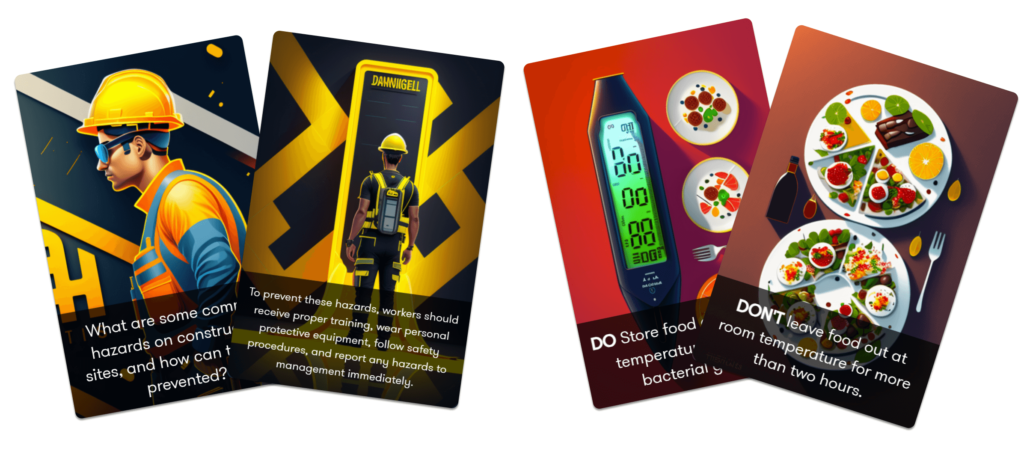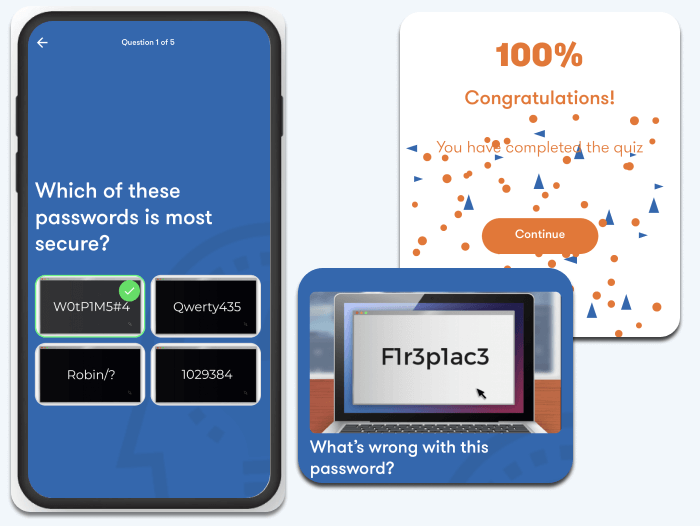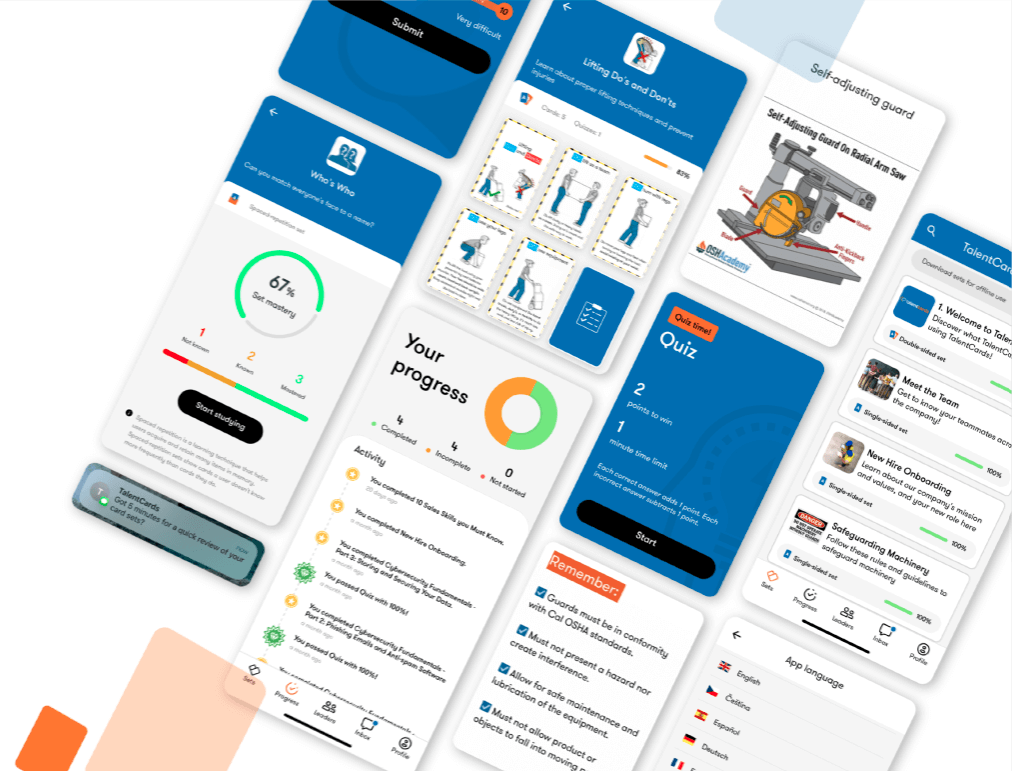Whether you have long-form training resources that you’d like to transform into microlearning activities, or you’d like to start creating microlearning courses from scratch, you might need some ideas to kick start your efforts.
That’s why we’ve compiled this list of 25 microlearning examples that you can use to enhance your existing training resources, or start creating new resources from scratch. These practical and tangible examples of microlearning are designed to help you incorporate the strategy in your organization, and make the learning experience effective and enjoyable for your whole team.
What are microlearning courses?
Microlearning courses are courses that are short, topic-specific, and easy to follow. They are used to teach employees a new skill, improve and build on existing skills, and to refresh and reinforce information that a person has learned in the past.
The characteristics that make microlearning courses so powerful (when done correctly) are that they are straight to the point, and can be delivered in various formats— from audio, to video, to images and infographics, or a combination of all three.
By providing employees with microlearning courses you decrease the likelihood of information and cognitive overload, which is a common side effect of longer, one-time training sessions. Instead you give employees the opportunity to brush up on important job information in just a few minutes, as well as keep that information available for review at any time it’s needed.
But how do you actually present information in a microlearning format? These 25 ideas are tangible examples of how you can incorporate microlearning into your training materials today.
25 examples of microlearning
1. Mobile flashcards
Mobile flashcards are one of the best microlearning examples. They’re just like the flashcards you had in school as a student, but in a digital format on your phone or tablet. They’re a convenient way for learners to carry around information that’s easy to access, right in their pockets.

Creating mobile flashcards is incredibly easy with the right mobile learning software. They’re great for creating content that takes the form of question/answer, word/ definition, or any other prompt and response format.
2. Micro videos
Presenting information in a video format is ideal for when you want to train employees on step by step processes, or to demonstrate soft skills, such as effective communication and presentation skills. Just keep in mind that your microlearning videos shouldn’t be too long, with the ideal length being between 3 – 7 minutes.
If the topic you’d like to deliver training on can’t be effectively communicated in this time span, consider breaking the video into shorter segments. Even just the act of dividing one long video into multiple smaller videos will make it easier on learners who now see manageable learning units that they can work through, instead of one long video that will take up too much of their time.
3. Short audio clips
These are great for training that requires less of a visual element and more of an auditory one. For example, proper wood pronunciation for language learning, or soft skills training for team members working in customer support or sales.
By recording and sharing an audio clip of how to properly address customers, explain processes, or handle complaints, you’ll give your employees a real life example that they can learn from and reference back to in just a few minutes.
4. Question of the day
By sharing a daily question with your employees to answer you keep important job info front of mind on a regular basis, as well as encourage continuous learning in the organization. With the right microlearning platform you can automate this process so that questions are sent out at the same time every day, as well as gain valuable insights on which topics employees are knowledgeable in, and which requires some extra review.
5. Spaced repetition
Spaced repetition is a learning technique designed to help people memorize information. Learners are presented with information, and then they review this information again at gradually increasing intervals. You might distribute training material on a topic that by nature requires frequent reviewing, such as cybersecurity or workplace safety, and then have employees review it again the following day, and then again after three days, and then again after one week, and so on.
Spaced repetition and microlearning go hand in hand because the process of reviewing the information really only needs to take about five minutes of the learner’s time. This technique has been shown to have a massively positive impact on memory retention over time.
6. Step by step guides
A well written step by step guide can go a long way in training new hires and employees on job processes. While a step by step guide can become lengthy if it’s for a complicated process, the time the learner has to spend reviewing it directly depends on how well thought out the guide is. This is why it’s critical that you take the time to ensure that the guides you create are as concise and direct as possible, so that learners can get the info they need from them in under ten minutes.
Also note that step by step guides can be delivered in the form of mobile flashcards that we mentioned before. You can use single-sided flashcards (flashcards that only have content on the front) to present the steps of a process and include all the necessary diagrams or images to go along with your text.
7. Micro quizzes
Not all of your microlearning elements need to involve presenting new information to employees. In fact, it’s good practice to also create elements that evaluate learner knowledge. This is where micro quizzes come in.
These short quizzes should take learners just a few minutes to complete, and can include multiple choice questions, fill in the blank, matching, and more. By sharing a micro quiz with your employees every once in a while you’ll help them reinforce their knowledge, as well as gather feedback on which areas of their training they may be struggling with.

8. Retrieval practice
Retrieval practice involves testing learners’ knowledge by asking them to recall information from memory, as opposed to simply pushing out that information to them again as a reminder or refresher. This technique is particularly powerful when used in the days after a training session has been completed.
By asking employees to share what they learned during their training you’re asking them to actively recall that information, making it more likely that it will stick in their mind in the future. You can put this learning method to work by making it one of your questions of the day as we mentioned before.
9. Spot the mistake
Sometimes it’s even more powerful to ask learners what’s wrong with something, instead of asking them to simply give you the right answer. This is where spot the mistake comes in.
For example, you can show an image of a work area, a piece of equipment that has been installed, or a job that has been carried out, and ask learners to identify which part has been carried out incorrectly. This exercise only takes a few minutes, but it has a sticky effect on learners’ memories for when they go to carry out that task themselves.
10. Vocabulary flash cards
Vocab flashcards are the most classic language learning method in the book, and for good reason. They’re very powerful and convenient for learners to practice and memorize new words, and only take up a few minutes at a time.
11. Fact of the day
Fact of the day is a microlearning approach that involves presenting learners with a new idea or concept each day in order to keep them up to date in their roles and promote continuous learning. One of the positive side effects of this learning approach is that it helps employees develop a habit of daily learning, and encourages them to think critically about new ideas and concepts.
12. Matching pairs
Matching pairs is a fun and gamified way to test learners’ knowledge. As the name suggests, you ask employees to correctly match together corresponding elements. For example, you can ask employees to match an image of a product with its corresponding description, or which tools are used for carrying out which jobs.
13. Ordering steps
Ordering steps is an effective technique for helping employees reinforce how to carry out complex processes or jobs. Simply present learners with the steps of a process in a scrambled order, and then ask them to place the steps in the correct order. This technique is also helpful for managers because the results of this activity will help them identify which parts of a process employees struggle with the most, and pinpoint common mistakes on the job.
14. Who’s who
Who’s who is a microlearning activity that helps the members of your team get to know all of their colleagues’ names, faces, positions, and any other info you’d like to include. This activity is well-suited for mobile flashcards: on the front of the card you add the person’s photo, and on the back of the card you add their name and other relevant information. This way learners quiz themselves on if they can recall the person’s name and job role.

You can also create spaced repetition card sets with this activity, which will allow learners to identify which names and faces they’ve mastered, so that they then spend more time studying the ones that are unfamiliar.
15. True/false
The powerful thing about true/false questions is that they take very little time for learners to answer, but reveal a lot about how well they’ve mastered their training. True/false questions allow you to ask very specific questions that can have a level of trickiness to them, allowing you to test employees’ attention to detail.
16. Word of the day
Similar to the question of the day, word of the day is another short but powerful microlearning activity that takes just a few minutes and creates a habit out of daily learning. It’s a great strategy for language learners or people who are looking to expand their vocabulary in general.
17. Charts & diagrams
Depending on the training you’d like to deliver, text may not serve your purpose at all. Sharing a chart or diagram for employees to have as a reference point can be a much more powerful way of conveying information.
18. Fast facts
Fast facts are great for refreshing employees’ knowledge on important topics that they might have learned about in previous training sessions. For example, cybersecurity is a topic that requires constant attention, and it can be helpful to provide fast facts that highlight the most critical points for employees to review.
Fast facts are an excellent option for employees who don’t have a lot of time to spend on training and need a some quick refresher training, so make sure that you present them as concisely as possible, taking advantage of bullets and list formats.
19. Checklists
Checklists are helpful for ensuring that employees have completed every step of a process and haven’t missed any details. They also serve as valuable resources that break down complicated tasks into manageable steps.
For example, you might create a checklist of opening and closing procedures to help reduce the likelihood of any mistakes.
20. Fill in the blank
In fill-in-the-blank exercises, learners are given a sentence with missing words, and they must fill in the blanks with the correct answers. This type of exercise is often used in language learning, but it can also be used in other areas, such as product training or compliance. For example, you might provide employees with a sentence about a particular product or service, with a few missing words that they need to fill in based on their training.
21. Translate the phrase
Translate the phrase is another example of microlearning in language learning. In this exercise, learners are given words or phrases in one language and asked to translate them into another. This exercise only takes a few minutes and it helps learners keep their grammar skills and vocabulary sharp.
22. Out loud explanations
Out loud explanations are exercises that help learners practice their verbal communication skills and take up just a few minutes of their time. In this exercise, learners are given a topic or asked a question, and they must verbally explain the solution.
For example, you might ask employees how to respond to a common customer complaint. Or perhaps you have your sales associates practice their short pitches out loud. The idea is to ask a question that makes sense for the learner to answer verbally, such as customer interactions, so that they can quickly practice this skill.
23. Dos and don’ts
Dos and don’ts are a type of microlearning exercise that provides employees with clear guidelines on what they should and shouldn’t do in a particular situation. For example, you might provide dos and don’ts for responding to customer complaints, handling confidential information, or dealing with workplace safety hazards.
24. List the steps
In this type of exercise, learners are asked to recall a set of steps from memory. For example, you might ask employees to list the five steps that must be followed for closing the restaurant each night. This type of exercise is a great way to reinforce knowledge and ensure that employees remember the critical steps in a process. Use this in conjunction with the order the steps strategy to ensure that employees not only remember all the steps, but can recall them in the correct order.
25. Who (or what) am I?
In this exercise, learners are given a description of a product, customer, process, service, or other entity, and they must identify who or what is being described. This type of exercise is helpful in reinforcing training about products, services, and other aspects of a business.
Create and share microlearning courses with your teams instantly.

FAQs
What makes a good microlearning course?
Microlearning courses should be short, focus on one topic at a time, relevant, and easily accessible. These characteristics make microlearning courses powerful learning tools for reinforcing knowledge and providing training on an as needed basis.
What is the purpose of microlearning?
The purpose of microlearning is to deliver concise and targeted pieces of learning content that are designed to help learners acquire new knowledge and skills quickly and efficiently. The goal is to provide learners with information that is easy to consume, understand, and retain, rather than overwhelming them with large amounts of information all at once.
A little microlearning can produce macro results
To make your microlearning have a macro impact in your company you don’t need to implement all 25 of these examples. Instead, take a moment to evaluate the training topics that are good fits to cover using microlearning, and then pick the right microlearning platform that will make delivering your content a smooth process for both your managers, and your employees.


